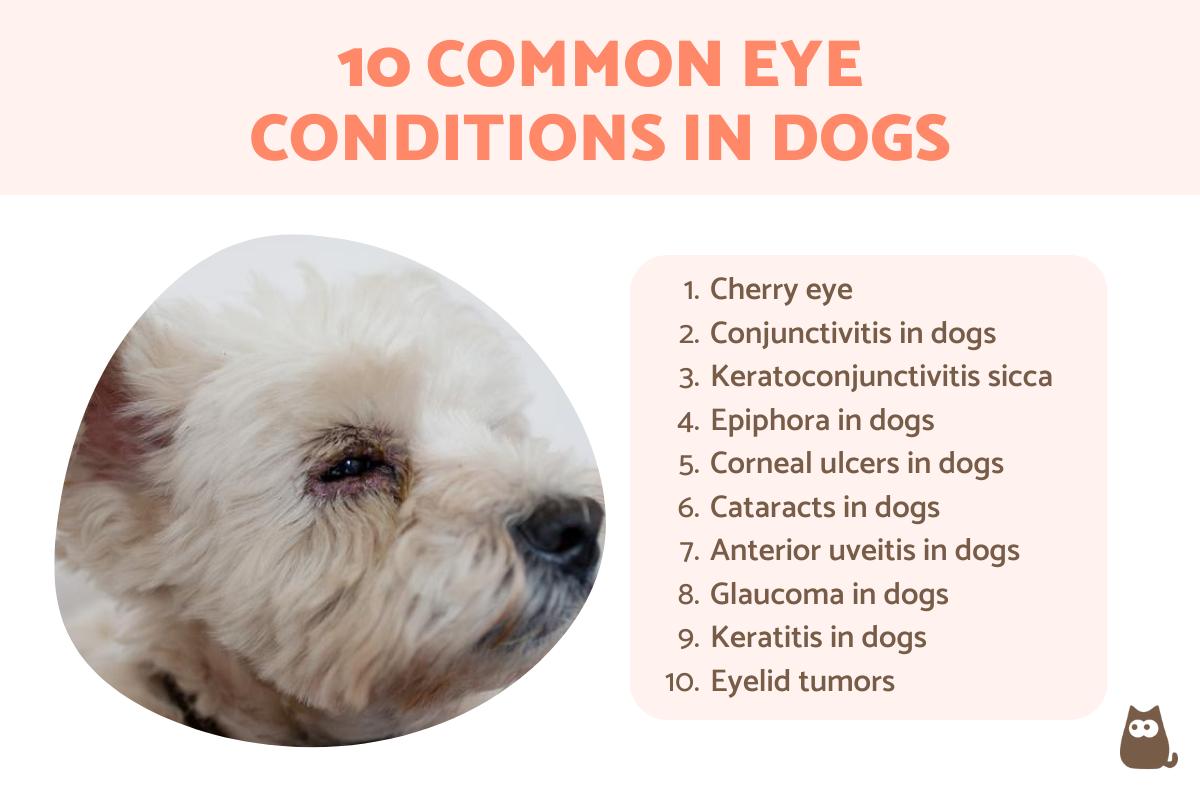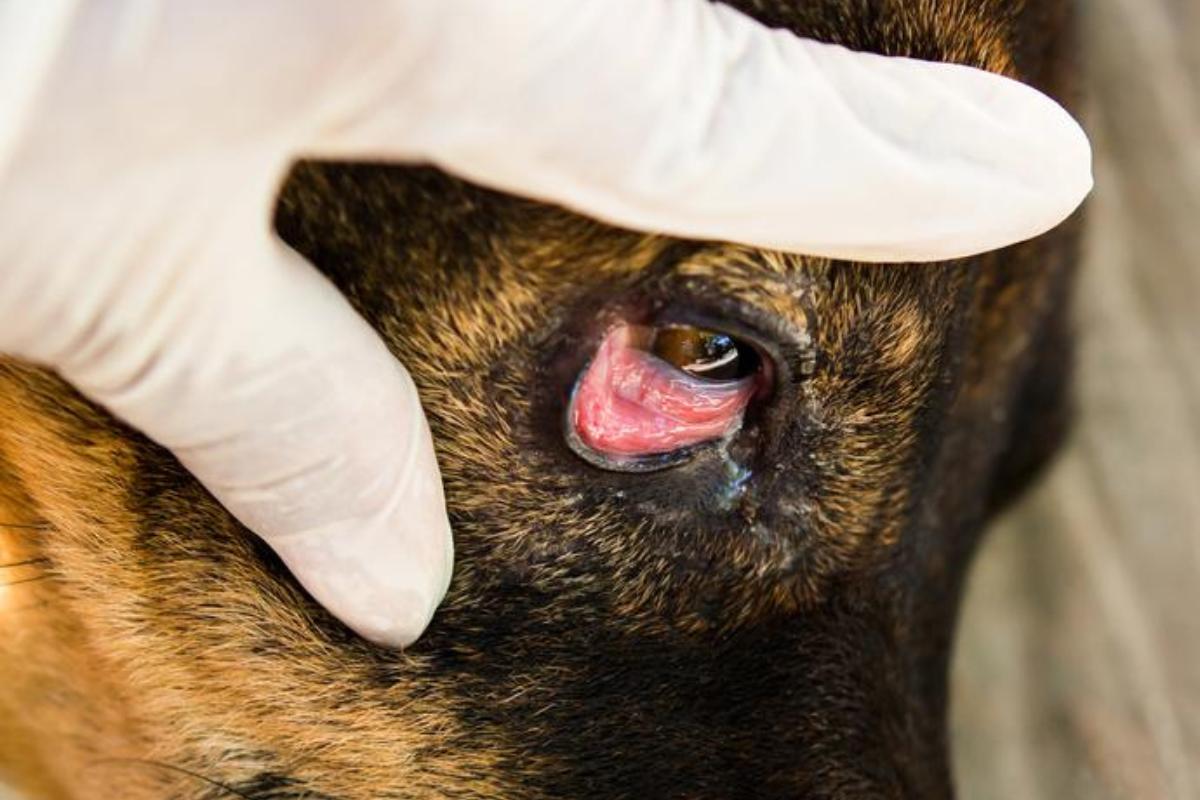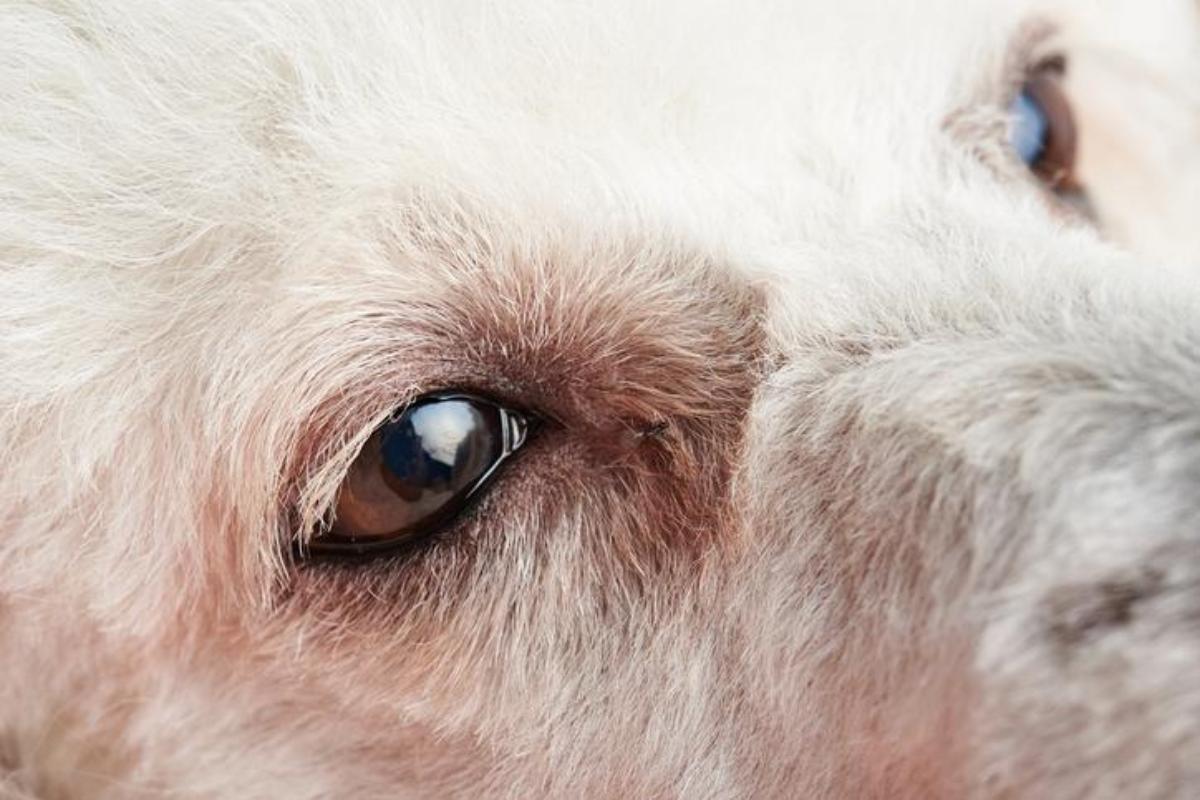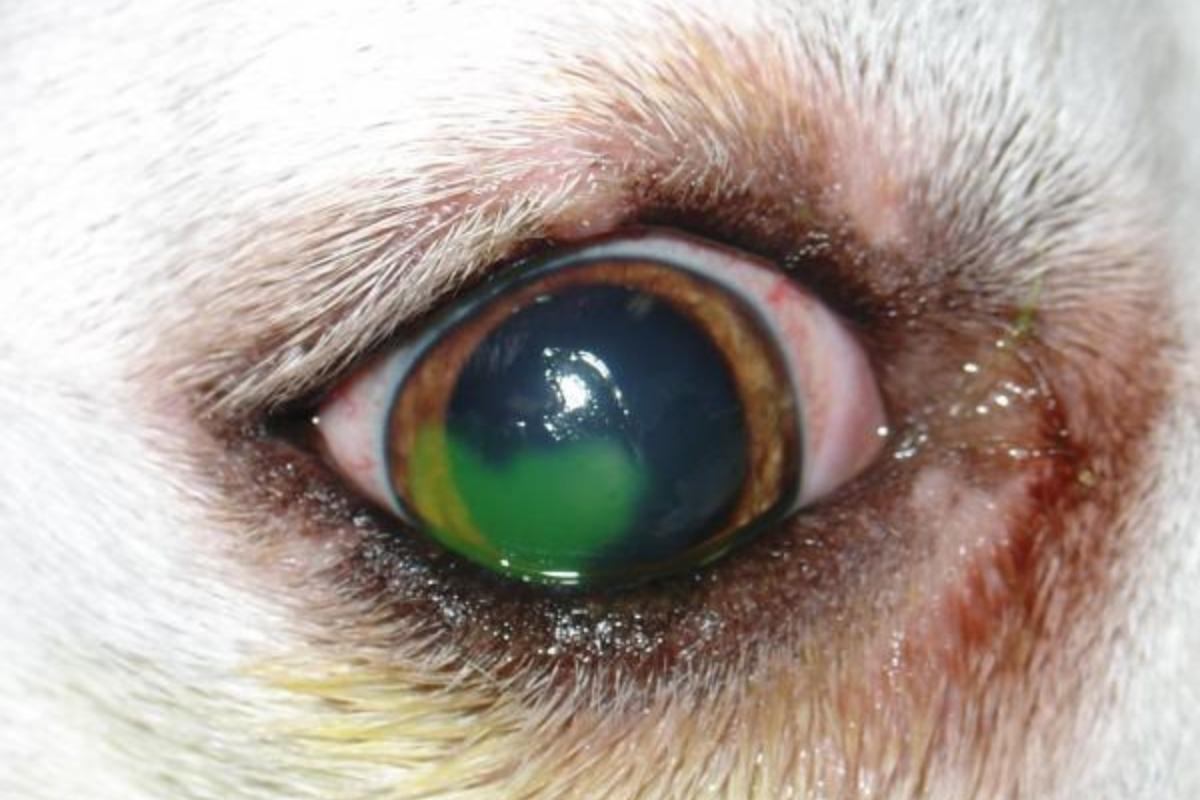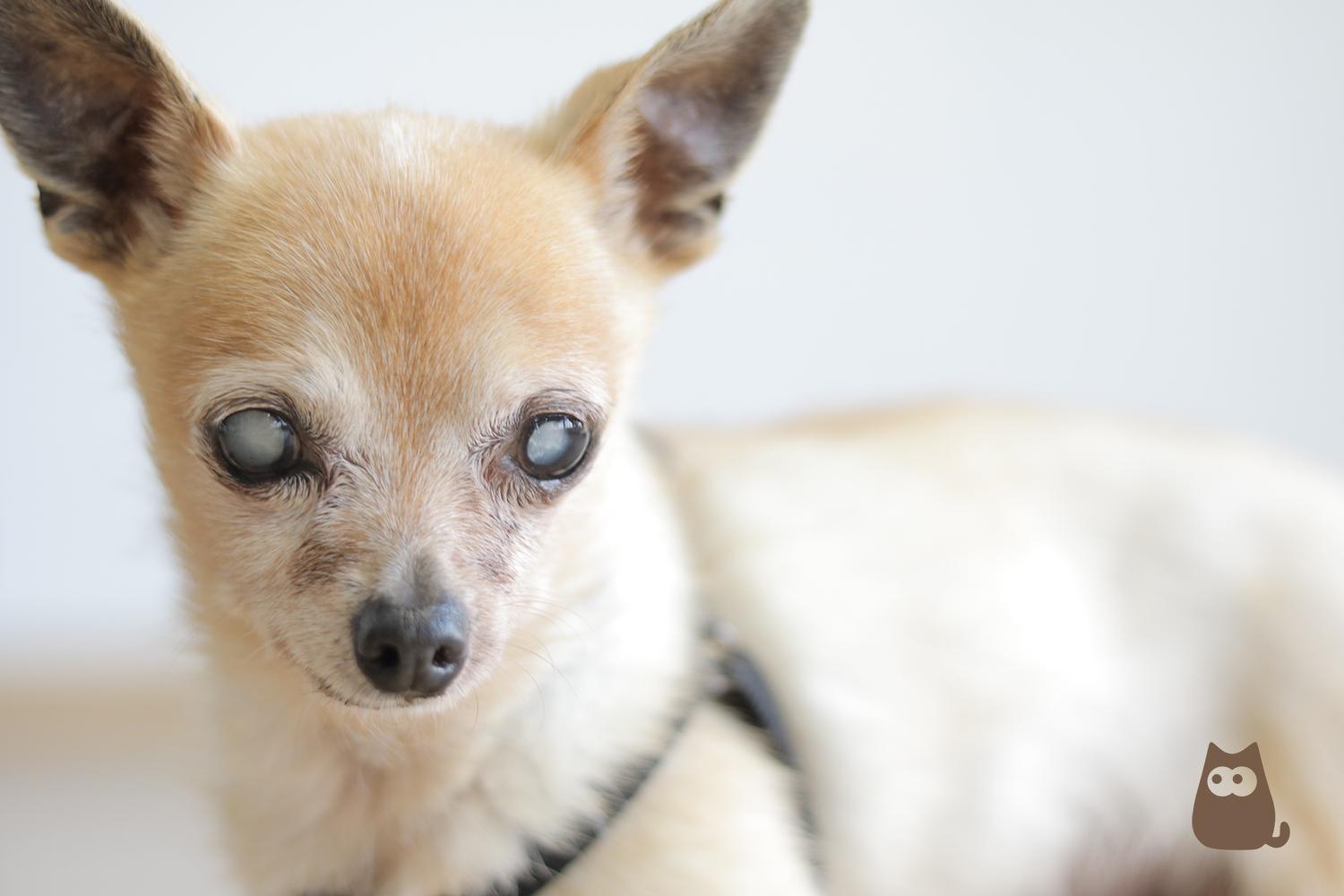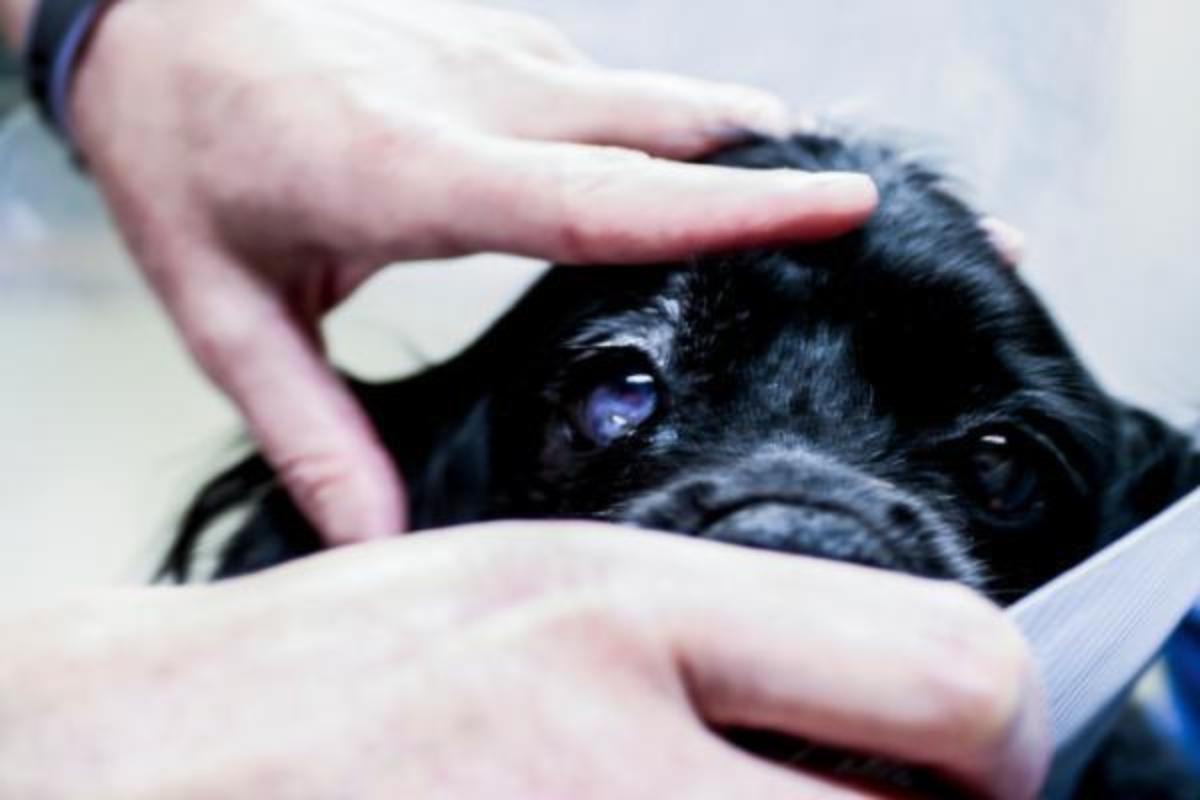Common Eye Conditions in Dogs



See files for Dogs
Depending on the type of canine eye problem, it can be difficult to observe symptoms in our dog. If they have an infection, we can easily see swelling and redness of the eye. If they are having an internal problem which is affecting their vision, we may not be aware of the issue until it has progressed to a greater extent. For this reason, we need to be very aware of any alterations not only to the dog's eyes themselves, but to the dog's behaviors which may alert us to an eye problem.
At AnimalWised, we share 10 common eye conditions in dogs can be caused by climate factors, foreign bodies, bacteria, congenital causes and even trauma to the eye. Symptoms alerting us to these canine eye problems include discharge, pain, swelling or redness, as well as incoordination caused by limited visibility.
- 10 Common eye conditions in dogs
- Cherry eye
- Conjunctivitis
- Keratoconjunctivitis sicca
- Epiphora
- Corneal ulcers
- Cataracts
- Anterior uveitis in dogs
- Glaucoma
- Keratitis
- Eyelid tumors in dogs
10 Common eye conditions in dogs
A dog's eyes are sensitive organs which are susceptible to various conditions, diseases and problems. While dogs are known for their acute sense of smell, their vision is generally very good. While they are slightly more nearsighted than humans, they have a better field of vision and it is acute at short distances. While it is a myth that dogs only see in black and white, they do have a more limited color vision.
Regardless of their acuity, a dog's eyes can be prone to various diseases. This is influenced by their environment. Dogs that have their hygiene neglected by their owners are more susceptible to a range of eye problems, especially those related to bacterial infection. Also, if a dog is allowed access to wooded areas with lots of low branches, this can increase the risk of trauma or a foreign body entering their eye.
Individual genetic and health factors can also influence the likelihood of developing some of the common eye conditions in dogs. Some dog breeds are brachycephalic and have bulging eyes as a result. These include breeds such as the Pug and Boxer dog. Due to the greater exposure, the eyes are more vulnerable to external factors. Also, dogs that have immune-mediated diseases may be more prone to canine eye infections or other diseases.
With these factors in mind, we can say that the 10 most common eye conditions in dogs are the following:
- Cherry eye
- Conjunctivitis in dogs
- Keratoconjunctivitis sicca or dry eye syndrome (DES)
- Epiphora in dogs
- Corneal ulcers in dogs
- Cataracts in dogs
- Anterior uveitis in dogs
- Glaucoma in dogs
- Keratitis in dogs
- Eyelid tumors
Keep reading for more about the causes, symptoms and treatment of each of these above mentioned canine eye problems.
Cherry eye
The most obvious symptom of this canine eye problem is dog’s third eyelid showing. Cherry eye in dogs is also referred to as the prolapse of the third eyelid tear gland. It causes an exposure of the lacrimal gland that is located in a dog’s third eyelid. This exposed gland irritates the ocular surface and may result in conjunctivitis, meaning it cannot be ignored.
Cherry eye often has a genetic influence in its development. Some dog breeds like Cocker Spaniels and Beagles are more prone to it as congenital defect than other dogs. However, age, environmental factors or even trauma can influence the development of this common eye condition in dogs. Often an environmental factor might trigger a genetic condition.
Cherry eye in dogs symptoms include:
- Eye redness
- Eye discharge
- Impaired vision
- Dry eyes
- Swelling
- Rubbing of eyes
- Squinting
Cherry eye treatment usually requires surgery. This is because this gland produces tears. If removed completely, it could cause dry eye syndrome in dogs due to a reduction in tear production. For this reason is it more advisable to replace it. Over time, it is relatively common for the problem to reoccur.
For more, we recommend reading our article where we discuss why does my dog scratch its eyes?

Conjunctivitis
Often known as pink eye, conjunctivitis in dogs results in an inflammation in the conjunctiva along the eye lid causing redness and secretion. Canine conjunctivitis causes include, allergies (affecting both eyes), bacterial infection, lowered immunity or foreign objects stuck in a dog's eye. The different types of conjunctivitis include:
- Serous conjunctivitis: apparent clear, transparent and watery secretion, usually caused by wind or dust. Produces itching.
- Mucus conjunctivitis: apparent mucous secretion that originates in third eyelid follicles, caused by any irritant or infection.
- Purulent conjunctivitis: apparent presence of pus due to bacteria. This secretion will form crusts on the eyelids.
Conjunctivitis treatment depends on the exact cause. The affected eye(s) must be cleaned thoroughly and medication must be administered by a veterinarian only. For more, we recommend reading our article where we tell you everything you need to know about conjunctivitis in dogs and its causes and symptoms.

Keratoconjunctivitis sicca
Also known as dry eye syndrome (DES), keratoconjunctivitis sicca is caused by a lacrimal gland disorder. This then results in an insufficient production of tears, causing the cornea to dry out. The characteristic sign of this condition is the appearance of a thick, mucous or mucopurulent discharge. If you notice these symptoms and secretions, usually accompanied by a dullness in the eyes, you should go to a veterinarian. Immediate treatment is necessary to avoid the cornea becoming affected, which could result in blindness.
Different dry eye in dogs causes include:
- Immune mediated diseases
- Lesions in the lacrimal glands due to canine distemper
- Addison’s diseases
- Idiopathic (of unknown origin)
Diagnosis is carried out by measuring tear volume with a Schirmer’s test. Medical treatment such as immunosuppressants are often administered for life.

Epiphora
Epiphora (eye discharge) is known as a symptom rather than an eye disease. Epiphora in dogs is characterized by continuous tearing. This constant moisture can lead the eye area to swell and become infected. This is commonly considered to be an aesthetic problem, but can also be a symptoms or sign of a foreign object stuck in a dog’s eye. For this reason, veterinary consultation is necessary.
Epiphora or eye discharge is a common dog eye condition which targets specific breeds such as Poodles, Maltese or Pekingese. Epiphora may also appear as a reddish-brown spot under the eye. Epiphora treatment includes cleaning and wiping the dog’s eyes, possible surgery or a flushing of the eyes. All treatment will need to be administered by a professional.

Corneal ulcers
Corneal ulcers are lesions that affect the middle and inner layer of the cornea. This dog eye disease often occurs as a result of trauma. Other causes of corneal ulcers in dogs include keratoconjunctivitis sicca, diabetes or Addison’s disease. The lesion can be seen in the picture below as the green patch in the bottom right of the eye.
Corneal ulcers can be extremely painful, causing lacrimation and photophobia. A veterinarian confirms their presence by instilling fluorescein in the eye, dyeing them green. If you believe your dog is suffering from corneal ulcers, we recommend going to a veterinarian immediately. If not treated, it can result in blindness and eye loss. Medication is often prescribed. In more serious cases, surgery may be necessary. Indolent ulcers are eye conditions more common in breeds like Boxers, Samoyeds or types of Poodles. This is a specific ulcer type that takes longer to heal.

Cataracts
Cataracts involve the loss of transparency of the eye lens, shown in the picture below. Cataracts are visible as grayish covers over the pupils. This often hereditary disease can be considered congenital cataracts or juvenile cataracts. Juvenile cataracts generally appear before the age of six in both eyes, although not always simultaneously[1].
Acquired cataracts are a consequence of aging or other diseases in the dog. This include senile cataracts that begin in the center of the lens and spread outward. Cataract treatment for dogs is usually surgical, although some juvenile cataracts spontaneously reabsorb themselves within a year. For more, we recommend reading our article where we discuss what causes cloudy eyes in dogs.

Anterior uveitis in dogs
Anterior uveitis in dogs or eye inflammation of dogs refers to when the ciliary body inflames. This inflammation then spreads to the iris and produces aqueous humor. It is a common symptom of several different diseases. Anterior uveitis in dogs is extremely painful and can cause lachrymation, redness, photophobia and a protrusion of the third eyelid.
In addition, the dog’s pupil will appear dwarfed as well as have difficulty reacting to light. Another possible eye inflammation symptom may include misty dog eyes. Anterior uveitis treatment includes treating the specific cause which will be need to be diagnosed by a veterinarian. In the picture below, we can see how the inflammation has spread in the left eye.

Glaucoma
Glaucoma in dogs is a very serious condition which can result in blindness. Glaucoma occurs when a greater amount of vitreous humor is produced than is eliminated, increasing pressure inside the eye as it does so. This results in alterations of the optic nerve and retina. Hereditary glaucoma is more common in breeds like the Beagle, Cocker Spaniel or Basset Hound. Secondary glaucoma results as a symptom of another disease or trauma.
Acute glaucoma symptoms includes pain, tearing, hardened eyes, corneal haze and enlarged pupils. Chronic glaucoma enlarges and protrudes the already blind eyeball. To avoid blindness, acute glaucoma must be treated immediately, implanting medication that lowers the intra-ocular pressure. Treatment may also include surgery. In chronic glaucoma, extirpation must be assessed, since the eye, although blind, may continue cause pain and injury[2].
For more, we recommend reading our article where we tell you everything you need to know about glaucoma in dogs.

Keratitis
Keratitis in dogs consists of inflammation of the cornea. As seen in the picture, the eyeball becomes cloudy and loses transparency. Keratitis symptoms include intense lacrimation, photophobia and protrusion of the third eyelid.
There are different types of keratitis in dogs, such as ulcerative, infectious, interstitial, vascular and pigmentary. All types must be treated accordingly to avoid blindness. For more, we recommend reading our article where we discuss the types, causes, diagnosis and treatment of keratitis in dogs.

Eyelid tumors in dogs
Tumors of the eyelid in dogs include palpebral tumors, the most common being an adenoma in the Meibomian glands. These are glands that are located in the eyelids and produce a sebaceous substance. These tumors can look like a little piece (or pieces) of cauliflower.
Other frequent dog eyelid tumor types include sebaceous adenomas, which are usually benign and more common in older dogs. You may also notice an appearance of warts, caused by the oral papilloma virus in dogs.
All cases of tumors in dogs require surgical removal to avoid rubbing an corneal injury. For more, we recommend reading skin tumor in dogs.

This article is purely informative. AnimalWised does not have the authority to prescribe any veterinary treatment or create a diagnosis. We invite you to take your pet to the veterinarian if they are suffering from any condition or pain.
If you want to read similar articles to Common Eye Conditions in Dogs, we recommend you visit our Eye problems category.
1. Urfer, S. R., Greer, K., & Wolf, N. S. (2011). Age-related cataract in dogs: a biomarker for life span and its relation to body size. Age (Dordrecht, Netherlands), 33(3), 451–460.
https://doi.org/10.1007/s11357-010-9158-4
2. Boillot, T., Rosolen, S. G., Dulaurent, T., Goulle, F., Thomas, P., Isard, P. F., Azoulay, T., Lafarge-Beurlet, S., Woods, M., Lavillegrand, S., Ivkovic, I., Neveux, N., Sahel, J. A., Picaud, S., & Froger, N. (2014). Determination of morphological, biometric and biochemical susceptibilities in healthy Eurasier dogs with suspected inherited glaucoma. PloS one, 9(11), e111873.
https://doi.org/10.1371/journal.pone.0111873


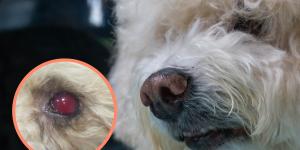
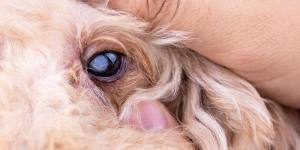
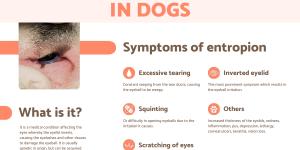

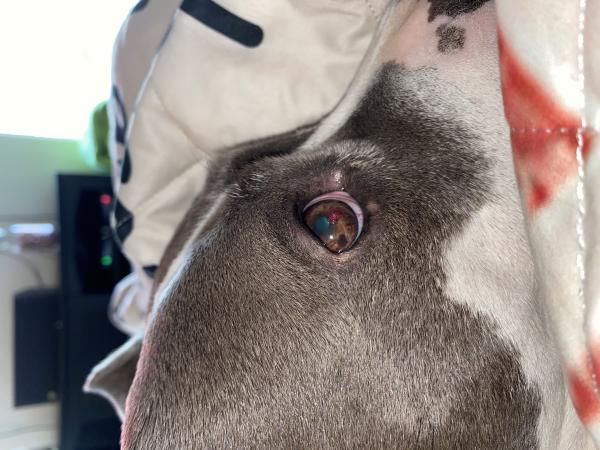 What is this?
What is this?


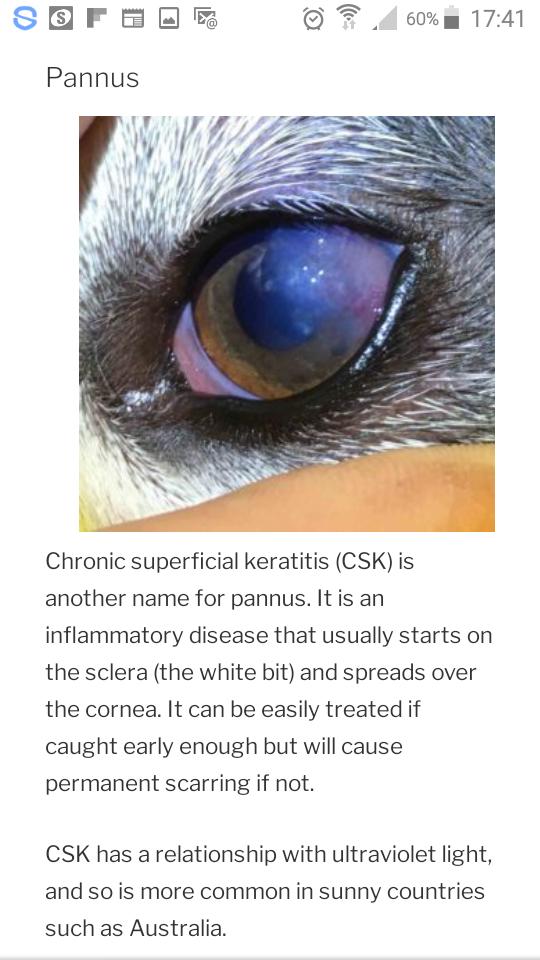 My westie has developed like a white cover on his eye & he's squints
My westie has developed like a white cover on his eye & he's squints
